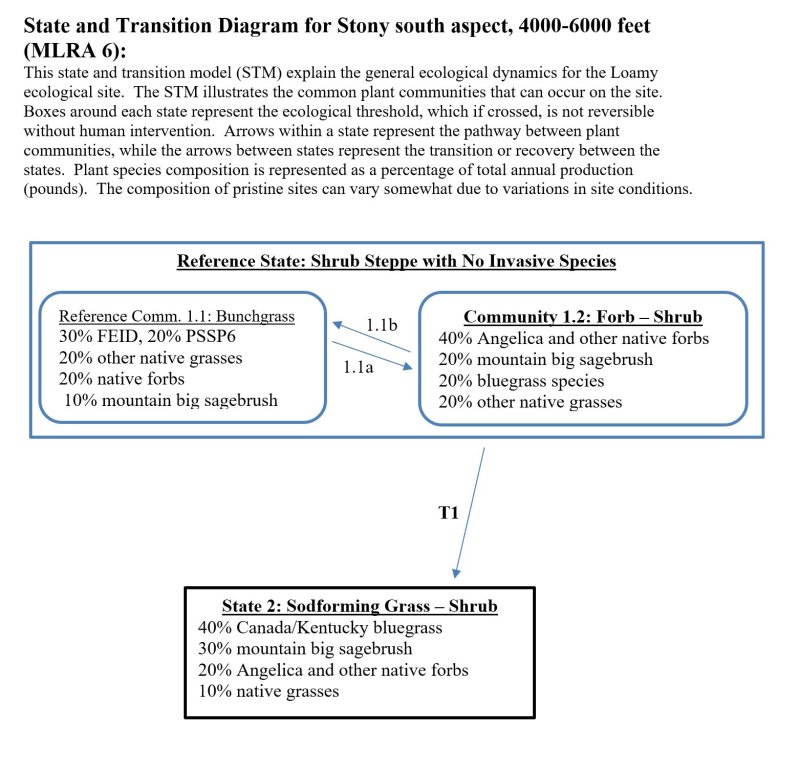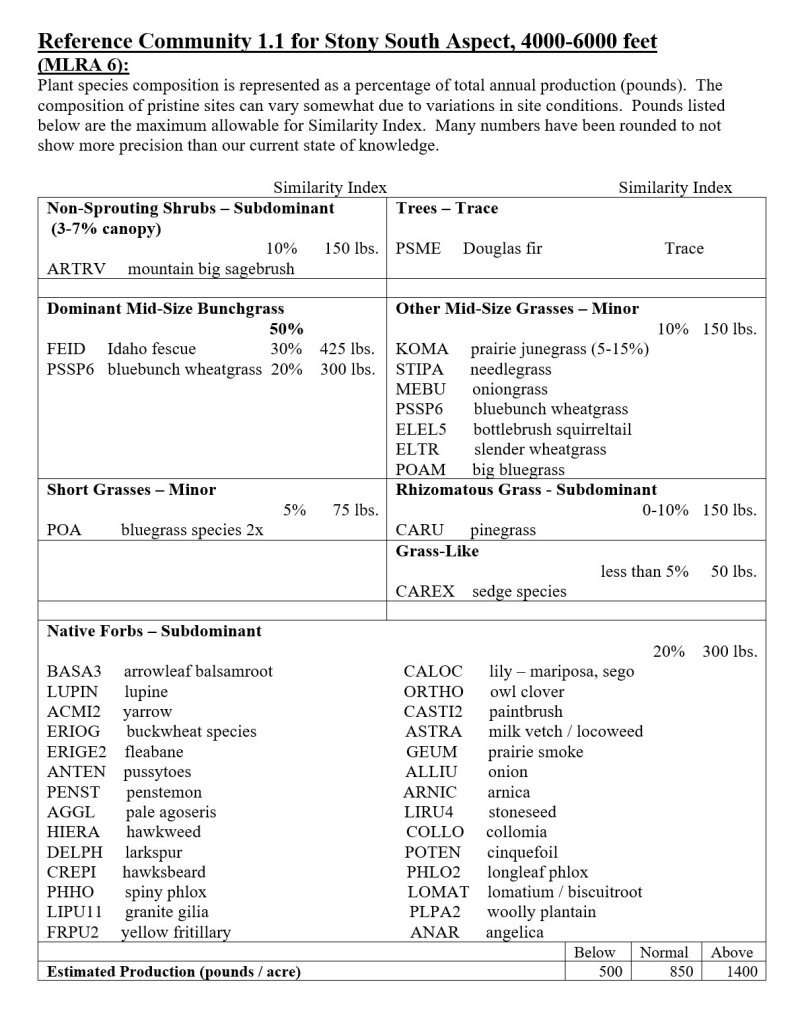Ecological site group R006XG126WA
Stony south aspect, 4000-6000 feet
Last updated: 09/21/2023
Accessed: 12/21/2025
Ecological site group description
Key Characteristics
None specified
Provisional. A provisional ecological site description has undergone quality control and quality assurance review. It contains a working state and transition model and enough information to identify the ecological site.
Physiography
Hierarchical Classification
Major Land Resource Area (MLRA): 6 – Cascade Mountains, East Slope
Land Resource Unit (LRU) – Common Resource Areas (CRA):
6.1 – North Cascades Subalpine/Alpine
6.2 – Pasayten/Sawtooth Highlands
6.3 – Okanogan Pine/Fir Hills
6.4 – Chelan Tephra Hills
6.5 – Chiwaukum Hills and Lowlands
Site Concept Narrative:
Diagnostics:
More than 80% of the landscape of MLRA 6 is forest. This site stands out because of a lack of trees.
Stony south aspect, 4000-6000 feet is an upland site at mid elevations (4000-6000 feet) in the 18-25” precipitation zone of MLRA 6. This site is found on southeast and south to west aspects. Level areas and other aspects are forest. The soils are generally deep and stony. Sandy loam and loam are the main textures.
Stony south aspect, 4000-6000 feet Reference Community is a shrub steppe site. Bluebunch wheatgrass and Idaho fescue are co-dominant in the reference state while other grasses include prairie junegrass and needlegrass. Native forbs fill the interspaces.
Principle Vegetative Drivers:
The vegetative expression of this ecological site is driven by the combination of five factors:
(1) Elevation between 4,000 and 6,000 feet
(2) 18-30 inches of precipitation
(3) The southeast and south, to west aspects
(4) Moderately deep to deep soils provide unrestricted rooting for most species
(5) Timing and amount of late-May and June precipitation
Influencing Water Features:
A plant’s ability to grow on a site and overall plant production is determined by soil-water-plant relationships
1. Whether rain and melting snow runs off-site or infiltrates into the soil
2. Whether soil condition remain aerobic or become saturated and become anaerobic
3. Water drainage and how quickly the soil reaches wilting point
With adequate cover of live plants and litter, there are no restrictions on Loamy sites with water infiltrating into the soil. These sites are well drained and are saturated for only a short period.
Physiography of MLRA 6:
Most of MLRA 6 is in the Northern and Middle Cascade Mountains. This mountainous area consists of sharp alpine summits with some higher volcanic cones to the west, and lower lying foothills to the east. Strongly sloping mountains and U-shaped valleys are dominant in the north, with eroded basalt plateaus more typical in the south. The East Slope of the Cascades is a transitional area between the moist, rugged Cascade Mountains to the west and the drier, lower lying Columbia Basalt Plateau to the east. MLRA 6 has some of the landforms typical of both mountains and plateaus.
Physiographic Division: Pacific Mountains
Physiographic Province: Cascade-Sierra Mountains
Physiographic Sections: Northern Cascade and Middle Cascade Mountains
Landscapes: Mountains
Landform: Sideslopes, shoulders, summits
Elevation: Dominantly 3,500 to 6,500 feet
Central tendency: 4,000 to 6,000 feet
Slope: Total range: 10 to 65 percent
Central tendency: 15 to 35 percent
Aspect: Dominantly southerly aspects
Geology:
MLRA 6 consists of Pre-Cretaceous metamorphic rocks cut by younger igneous intrusives. Tilted blocks of marine shale, carbonate, and other sediments occur in the far north, and some younger continental, river-laid sediments occur around Leavenworth, WA. Columbia River basalt is dominant in the southern portion of the state. Alpine glaciation has left remnants of glacial till, debris, and outwash in the northern part of this MLRA.
Climate
The climate across MLRA 6 is characterized by moderately cold, wet winters, and hot, dry summers, with limited precipitation due to the rain shadow effect of the Cascades. The average annual precipitation for most of the East Slope of the Cascades is 16-50 inches. Seventy-five to eighty percent of the precipitation comes late October through March as a mixture of rain and snow. The lowest precipitation occurs along the eastern edge, then increasing with rising elevation to the west. Most of the rainfall occurs as low-intensity, Pacific frontal storms during the winter, spring and fall. Rain turns to snow at the higher elevations. All areas receive snow in winter. Summers are relatively dry. The East Slopes experience greater temperature extremes and receive less precipitation than the west side of the Cascades. The shortest freeze-free periods occur along the western edge and the northern end of this MLRA, which are mountainous. The longest freeze-free periods occur along the Columbia River Gorge.
Mean Annual Precipitation:
Range: 16 - 30 inches
Central tendency: 18 – 22 inches
Soil moisture regime is xeric
Mean Annual Air Temperature:
Range: 39 to 45 degrees
Central tendency: 40 to 44 degrees
Soil temperature regime is frigid
Frost-free period (days)
Total range: 70 to 140
Central tendency: 90 to 120
The growing season is May to mid-August.
Soil features
Edaphic:
Stony south aspect, 4000-6000 feet ecological site commonly occurs with Shallow Stony 4000-6000 feet and Douglas fir ecological sites. This ecological site has moderately deep, well drained soils formed in loess.
Representative Soil Features:
This ecological site components are dominantly Vitrandic and Ultic taxonomic subgroups of Haploxerolls and Argixerolls great groups of the Mollisols. Soils are dominantly moderately deep or deeper. Average available water capacity of about 4.0 inches (10.2 cm) in the 0 to 40 inches (0-100 cm) depth range.
Soil parent material is dominantly mixed volcanic ash mixed with colluvium in the upper part of the soil over colluvium and residuum or glacial till.
The associated soils are Pelican, Sapkin and similar soils.
Dominate soil surface is gravelly ashy loam to very cobbly loam.
Dominant particle-size class is loamy-skeletal.
Fragments on surface horizon > 3 inches (% Volume):
Minimum: 0
Maximum: 2
Average: 0
Fragments within surface horizon > 3 inches (% Volume):
Minimum: 0
Maximum: 30
Average: 10
Fragments within surface horizon ≤ 3 inches (% Volume):
Minimum: 5
Maximum: 30
Average: 10
Subsurface fragments > 3 inches (% Volume):
Minimum: 5
Maximum: 40
Average: 15
Subsurface fragments ≤ 3 inches (% Volume):
Minimum: 10
Maximum: 50
Average: 30
Drainage Class: Well drained
Water table depth: Greater than 60 inches
Flooding:
Frequency: None
Ponding:
Frequency: None
Saturated Hydraulic Conductivity Class:
0 to 10 inches: Moderately high and high
10 to 40 inches: Moderately high and high
Depth to root-restricting feature (inches):
Minimum: 20
Maximum: Greater than 60
Electrical Conductivity (dS/m):
Minimum: 0
Maximum: 0
Sodium Absorption Ratio:
Minimum: 0
Maximum: 0
Calcium Carbonate Equivalent (percent):
Minimum: 0
Maximum: 0
Soil Reaction (pH) (1:1 Water):
0 - 10 inches: 5.6 to 7.3
10 - 40 inches: 6.1 to 7.3
Available Water Capacity (inches, 0 – 40 inches depth):
Minimum: 3.5
Maximum: 5.0
Average: 4.0
Vegetation dynamics
Ecological Dynamics:
Stony south aspect, 4000-6000 feet produces about 500-1450 pounds/acre of biomass annually.
In the Reference Community bluebunch wheatgrass and Idaho fescue are dominant. Both species are long-lived, mid-sized bunchgrasses. Idaho fescue is shorter and has a dense clump of shoots, while bluebunch wheatgrass is taller and is less dense. Bluebunch has an awned spike seed head while Idaho fescue has an awned panicle seed head. The ratio of Idaho fescue to bluebunch wheatgrass plants on any site can vary due to aspect and elevation.
Both grasses provide a crucial and extensive network of roots to the upper portions (up to 48” deep in soils with no root-restrictive horizons) of the soil profile. These roots create a massive underground source to stabilize the soils, provide organic matter and nutrients inputs, and help maintain soil pore space for water infiltration and water retention in the soil profile. The extensive rooting system of mid-sized bunchgrasses leave very little soil niche space available for invasion by other species. This drought resistant root can compete with, and suppress, the spread of exotic weeds.
The stability and resiliency of the reference communities is directly linked to the health and vigor of bluebunch wheatgrass. Refer to pages 8-9 for more details about bluebunch physiology. Research has found, on similar rangeland, that communities remain resistant to medusahead if sites maintain at least 0.8 mid-sized bunchgrass plant/sq. ft. (K. Davies, 2008). It is bluebunch that holds the system together. If we lose the bluebunch or Idaho fescue the ecosystem crashes or unravels.
The natural disturbance regime for grassland communities is periodic lightning-caused fires. Ponderosa pine communities have the shortest fire return interval (FRI) of about 10-20 years (Miller). The FRI increases as one moves to wetter or higher elevation sites.
Stony South Aspect, 4000-6000 feet does not regularly burn in August and September as it is normally quite green during fire season. However, the mountain sagebrush, which tend to increase over time, is quite susceptible to a sudden sharp drop in temperatures in late fall or early winter if not covered by snow. These events, very temperature dependent, will reduce a stand of mountain sagebrush to less than 5% canopy
Grazing is another common disturbance that occurs to this ecological site. Grazing pressure can be defined as heavy grazing intensity, or frequent grazing during reproductive growth, or season-long grazing (the same plants grazed more than once). As grazing pressure increases the plant community unravels in stages:
1. Idaho fescue and bluebunch wheatgrass have slight to moderate decline while shrubs and unpalatable native forbs increase
2. With further decline Canada/Kentucky bluegrass colonizes the site
3. The site can become dominated by Canada/Kentucky bluegrass
Managing grasslands to improve the vigor and health of native bunchgrasses begins with an understanding of grass physiology. New growth each year begins from basal buds. Bluebunch wheatgrass plants rely principally on tillering, rather than establishment of new plants through natural reseeding. During seed formation, the growing points become elevated and are vulnerable to damage or removal.
If defoliated during the formation of seeds, bluebunch wheatgrass has limited capacity to tiller compared with other, more grazing resistant grasses (Caldwell et al., 1981). Repeated critical period grazing (boot stage through seed formation) is especially damaging. Over several years each native bunchgrass pasture should be rested during the critical period two out of every three years (approximately April 15–July 15). And each pasture should be rested the entire growing-season every third year (approximately March 1 – July 15).
In the spring each year it is important to monitor and maintain an adequate top growth: (1) so plants have enough energy to replace basal buds annually, (2) to optimize regrowth following spring grazing, 3) to protect the elevated growing points of bluebunch wheatgrass, and (4) to avoid excessive defoliation of Idaho fescue with its weak stems.
Bluebunch wheatgrass and Idaho fescue remain competitive if:
(1) Basal buds are replaced annually,
(2) Enough top-growth is maintained for growth and protection of growing points,
(3) Idaho fescue makes viable seed and
(4) The timing of grazing and non-grazing is managed over a several-year period. Careful management of late spring grazing is especially critical
For more grazing management information refer to Range Technical Notes found in Section I Reference Lists of NRCS Field Office Technical Guide for Washington State.
In Washington, bluebunch wheatgrass communities provide habitat for a variety of upland wildlife species.
Supporting Information:
Associated Sites:
Stony South Aspect, 4000-6000 feet is associated with Shallow Stony 4000-6000 feet, Very Shallow and Douglas fir ecological sites.
Similar Sites:
Stony South Aspect, 6,000 – 7,600 feet in MLRA 6 in similar in some respects and different in other respects.
Inventory Data References (narrative):
Data to populate Reference Community came from several sources: (1) NRCS ecological sites from 2004, (2) Soil Conservation Service range sites from 1980s and 1990s, (3) Daubenmire’s habitat types, and (4) ecological systems from Natural Heritage Program
Major Land Resource Area
MLRA 006X
Cascade Mountains, Eastern Slope
Stage
Provisional
Contributors
Provisional Site Author: Kevin Guinn Technical Team: W. Keller, K. Paup-Lefferts, R. Fleenor, K. Bomberger
Click on box and path labels to scroll to the respective text.

